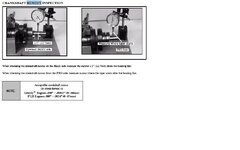Install the app
How to install the app on iOS
Follow along with the video below to see how to install our site as a web app on your home screen.
Note: This feature may not be available in some browsers.
crank runout
- Thread starter dktraw
- Start date
You are using an out of date browser. It may not display this or other websites correctly.
You should upgrade or use an alternative browser.
You should upgrade or use an alternative browser.
S
T
So how do you check runout without pullin the motor,, and/or taken the wole motor appart to get thecrank on a table like above image ?
S
I haven't done it so somebody that has can chime in but I would expect that you could pull the clutch (and maybe chassis stiffener), install the dial indicator as described above but attach it to the motor and pull it over or probably a better idea would be to turn the flywheel by hand. Similar process for the other side...
M
What a coincidence, i'm about to take my test equipment home today, and check the run-out tomorrow. On a 900 crank in a sled and another 2 cranks on a granite plate, will post the results as soon as.
What a coincidence, i'm about to take my test equipment home today, and check the run-out tomorrow. On a 900 crank in a sled and another 2 cranks on a granite plate, will post the results as soon as.
That would be great. If you would be willing to take some pictures as you go to show exactly how to do it and give a short report, it would be a great post to add to the How To thread.:beer;
Remove clutch, remove spark plugs, stick a dial indicator approxamately 12 mm in from the end of the crank and turn engine over slowly.
Zero your dial indicator at either the high point or low point on the crank. Then turn crank over slowly.
Zero your dial indicator at either the high point or low point on the crank. Then turn crank over slowly.
M
Have some pictures and a video clip of the measuring process, I'm in the process of trying to upload this stuff, which is not my expertize!
Also I think that copy from the manual in this post has a misprint, on the liberty engine it states 0.00 to 0.00014 (that's 1 and 1/2 tenths, real small stuff), but the conversion in metric says 0.00 to 0.04, which converts to 0.00 to 0.00157(which is nearly 16 tenths), which is more realistic. I double checked it against 3 other manuals, it's a misprint for sure!
Also I think that copy from the manual in this post has a misprint, on the liberty engine it states 0.00 to 0.00014 (that's 1 and 1/2 tenths, real small stuff), but the conversion in metric says 0.00 to 0.04, which converts to 0.00 to 0.00157(which is nearly 16 tenths), which is more realistic. I double checked it against 3 other manuals, it's a misprint for sure!
Anything over .003" and it's on it's way to needing attention.
You'll never see .007", it will break before then.
sled_guy
You'll never see .007", it will break before then.
sled_guy
M
Firstly, I'm a novice with this uploading stuff, so any suggestions or comments feel free. As for the mechanics of checking this crank, from the stationary images below is the setup I used, the bearings at each end are of different diameters, so the shim under one vee-block is to bring the crank closer to being parallel to the table (not exactly, but good enough for the purpose of checking runout).
Video 1. Indicator set at different points down the taper, but polaris wants 1/2 inch down after the taper starts, so this is the general principle shown.
Video 2. Same principle but at the other PTO end, Polaris wants the measurement just as the taper starts.
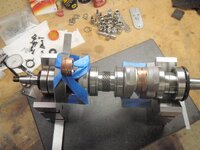
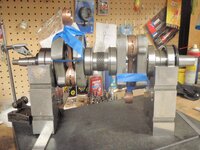
Video 1. Indicator set at different points down the taper, but polaris wants 1/2 inch down after the taper starts, so this is the general principle shown.
Video 2. Same principle but at the other PTO end, Polaris wants the measurement just as the taper starts.


M
Video 3. Magnetic base set on the top of the metallic shock tower. The indicator will reach down to the crank, approx as the taper starts.
The indicator will move one line which is equal to 5 tenths, when the recoil rope is engaged and tension is put on the engine ready to turn the crank over. But during the rotation, the indicator moves a total of 2 lines (10 tenths or one thousandth of an inch), Polaris wants 15 tenths run-out max, which is 3 lines.
So minus the 5 tenths tension on the motor ready to pull, this crank runs out about 5/6 tenths, about a third of the tolerance that Polaris allows.
Sorry for the clarity, but the tripod and zoom will be for another day.
Sure not everyone has access to the tools I have, but if you ever have the chance, try to verify that run-out before you put that balanced clutch on, the peace of mind you will have when you crush that throttle lever to the handle bar is "invaluable".
Hope it helps, and thanks to this forum in helping me build a reliable 900.
Mark
The indicator will move one line which is equal to 5 tenths, when the recoil rope is engaged and tension is put on the engine ready to turn the crank over. But during the rotation, the indicator moves a total of 2 lines (10 tenths or one thousandth of an inch), Polaris wants 15 tenths run-out max, which is 3 lines.
So minus the 5 tenths tension on the motor ready to pull, this crank runs out about 5/6 tenths, about a third of the tolerance that Polaris allows.
Sorry for the clarity, but the tripod and zoom will be for another day.
Sure not everyone has access to the tools I have, but if you ever have the chance, try to verify that run-out before you put that balanced clutch on, the peace of mind you will have when you crush that throttle lever to the handle bar is "invaluable".
Hope it helps, and thanks to this forum in helping me build a reliable 900.
Mark
Just to be clear, if you're checking run-out on assembled motor, whether it's in or out of chassis, one needs to fabricate a sturdy mounting plate (scrap steel) with which to attach mag base to the engine itself. With the 900, the threaded hole on lower crankcase, pto side, works perfect. This way eliminates any drift between movement of engine (crank) and chassis/workbench, and will give you accurate results. Also keep probe tip at a shallow angle in relation to crank snout. :heh:
Very Basic Example
Ok, I am going to do this short and sweet because I am short on time.
I have wondered why so many people have called me lately and told me they checked their 900 crank run-out and its perfect......I said wait a minute...... what do you mean by perfect ?? they would say under a .001 I would follow up by saying WOW!!!! you are one of the lucky ones.
I would say how did you chk it they said like i saw on Snowest 900 Thread..... I said well ok then........ End of story, Well until I checked this thread this morning.
Lets get started -
First look at the 2 pictures I posted.
Second look at the pictures millwall posted ( Not picking on you Millwall ) Many crankshaft shops have made this mistake.
Third look at the pictues sloan188 posted ( VIA Polaris service manual )
To understand is to allow you to perform the task correctly.
Now keep in mind the photos you have seen. ( you might have to read this thread several times )
If you took this thread and the pictures you saw, and you believe what you saw you should have been completely confused. WHY ? you ask ?
Ok, The Polaris manual shows and old style crankshaft that is in fact sitting on a OEM Polaris issue crank stand.
Where as Millwall has an early release 900 crankshaft that is very rare because if you look close it does not show the common rubber center seals.........this one has sealed bearings like in the small block motors and you could actually sit this 900 crank on a center holder like the old Polaris stand but it would sit crooked because of the bearing lock ring which can be removed then it would sit square the the stand. ( if it sits crooked you can still accurately check it )
That being said notice the pictures I posted as the common 900 crank most people see it has 2 center rubber seals just inside the bearings.
Now notice where i have my V Blocks...........Hint - They are very narrow. ( Built them this way as to get them inbetween the wheel and the lock ring )
This post is all about V-Blocks......And the key here is V-Block location.
I took a picture of a 900 crankshaft that is in 5 pieces...........why you ask ??
Here's where you need to pay attention - If the crankshaft is 5 seperate pieces what good does it do to have the dial indicator on the crankshaft on the same piece that the V -Block is sitting on ???
For gods sake people !!! If the V-Block is under either the Mag Wheel or the PTO wheel and the indicator is also on that wheel every crankshaft is going to look almost perfect.
The center pin of the 900 crankshaft is the one place that is a constant.
The V-Blocks MUST be under the 2 center bearings....and then the indicator must be on the outside of either the MAG or PTO end.
There are ( 4 ) press points !!! Did you hear ME ??? I said ( 4 ) press points outside the center pin, the reason to check runout is to infact see if these ( 4 ) press points are infact tru in relation to the center pin.
sloan188 's picture is the only accurate thing in this thread and no one can even use it because the polaris stand does not work with center rubber seals because the crank will NOT sit down on the bearings it will sit on the seals and wobble all over the place.
There are a few VERY well knowen crankshaft builders in the USA that check crankshafts just as this thread shows to and when I get them in this shop brand new cranks will not even turn in a torqued crankcase.
I am sorry I don't have more time I hope you can understand what i saying here.
Dan
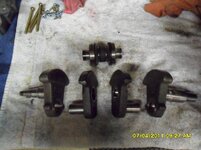
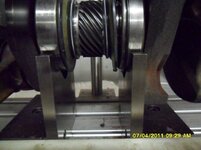
Ok, I am going to do this short and sweet because I am short on time.
I have wondered why so many people have called me lately and told me they checked their 900 crank run-out and its perfect......I said wait a minute...... what do you mean by perfect ?? they would say under a .001 I would follow up by saying WOW!!!! you are one of the lucky ones.
I would say how did you chk it they said like i saw on Snowest 900 Thread..... I said well ok then........ End of story, Well until I checked this thread this morning.
Lets get started -
First look at the 2 pictures I posted.
Second look at the pictures millwall posted ( Not picking on you Millwall ) Many crankshaft shops have made this mistake.
Third look at the pictues sloan188 posted ( VIA Polaris service manual )
To understand is to allow you to perform the task correctly.
Now keep in mind the photos you have seen. ( you might have to read this thread several times )
If you took this thread and the pictures you saw, and you believe what you saw you should have been completely confused. WHY ? you ask ?
Ok, The Polaris manual shows and old style crankshaft that is in fact sitting on a OEM Polaris issue crank stand.
Where as Millwall has an early release 900 crankshaft that is very rare because if you look close it does not show the common rubber center seals.........this one has sealed bearings like in the small block motors and you could actually sit this 900 crank on a center holder like the old Polaris stand but it would sit crooked because of the bearing lock ring which can be removed then it would sit square the the stand. ( if it sits crooked you can still accurately check it )
That being said notice the pictures I posted as the common 900 crank most people see it has 2 center rubber seals just inside the bearings.
Now notice where i have my V Blocks...........Hint - They are very narrow. ( Built them this way as to get them inbetween the wheel and the lock ring )
This post is all about V-Blocks......And the key here is V-Block location.
I took a picture of a 900 crankshaft that is in 5 pieces...........why you ask ??
Here's where you need to pay attention - If the crankshaft is 5 seperate pieces what good does it do to have the dial indicator on the crankshaft on the same piece that the V -Block is sitting on ???
For gods sake people !!! If the V-Block is under either the Mag Wheel or the PTO wheel and the indicator is also on that wheel every crankshaft is going to look almost perfect.
The center pin of the 900 crankshaft is the one place that is a constant.
The V-Blocks MUST be under the 2 center bearings....and then the indicator must be on the outside of either the MAG or PTO end.
There are ( 4 ) press points !!! Did you hear ME ??? I said ( 4 ) press points outside the center pin, the reason to check runout is to infact see if these ( 4 ) press points are infact tru in relation to the center pin.
sloan188 's picture is the only accurate thing in this thread and no one can even use it because the polaris stand does not work with center rubber seals because the crank will NOT sit down on the bearings it will sit on the seals and wobble all over the place.
There are a few VERY well knowen crankshaft builders in the USA that check crankshafts just as this thread shows to and when I get them in this shop brand new cranks will not even turn in a torqued crankcase.
I am sorry I don't have more time I hope you can understand what i saying here.
Dan


Last edited:
R
I Been truing mine the indydan way .and got 0.02mm pto and 0.03mm magside .should i now tigweld it
Or should i try to get it any closer?
Or should i try to get it any closer?
Last edited:



